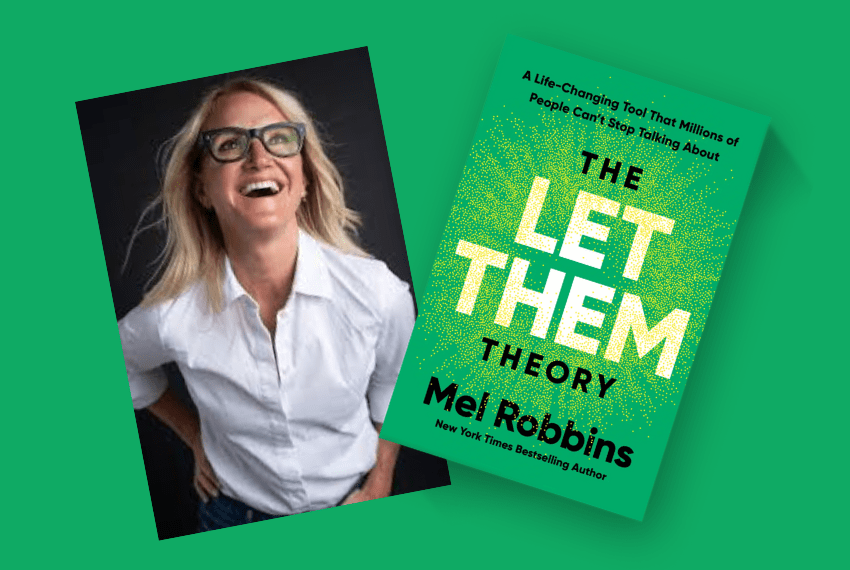
Introduction
I have been a fan of Mel’s for some time now. I love her no-nonsense, tell-it-like-it-is approach. She is very open about her own, as well as her family’s, struggles and applies the lessons she is teaching to them. Her previous two books, The 5 Second Rule and The High 5 Habit, have provided techniques that I have used and found effective along my own journey. This new book provides a whole new set of tools that I am adding to my toolkit.
Her approaches are the kind of things that when you hear them, you think, “why didn’t I think of that”. It just makes sense and can easily be applied in anyone’s life. This book is no different.
Have you ever found yourself spiraling into an overthinking abyss, wondering why someone didn’t text you back, why your coworker gave you that look, or whether your grocery cashier judged you for buying five different types of cheese? (They probably didn’t—but hey, let them.)
In The Let Them Theory, Mel Robbins presents a game-changing mindset shift: stop trying to control, fix, or obsess over what others think and do. Instead, let them. Let people have their opinions. Let them act how they want. Let them make their own choices. And most importantly—let yourself focus on what truly matters: your peace, your confidence, and your growth.
The problem isn’t you. The problem is the power you unwillingly give to other people.
While this book does touch on relationships, for the purposes of this blog, I’m more interested in how The Let Them Theory applies to breaking free from mental blockers such as self-doubt, fear, anger, and anxiety. I want you to be able to use this book to help with battling the mental barriers that keep you from living with certainty and confidence.
Key Takeaways from The Let Them Theory
At its core, The Let Them Theory is about surrendering control—not in a “give up on life and move into a cave” kind of way, but in a freeing, “stop gripping so tightly to things you can’t control” kind of way.
We stress about how people perceive us. We agonize over whether we’re “doing it right.” We let fear of judgment keep us from speaking up, taking risks, or living on our own terms. Robbins argues that the key to peace and confidence is not controlling others, but rather shifting your focus inward: “Let them do them, and me do me.”
Sounds simple, right? Well, sort of. But let’s get into how this applies to mental blockers like anxiety, self-doubt, anger, and fear.
How The Let Them Theory Helps Overcome Mental Blockers
1. Letting Go of the Need for External Validation
Raise your hand if you’ve ever held back on an idea, a goal, or even an outfit choice because you worried what other people might think. (If you didn’t raise your hand, you’re either enlightened or lying.)
Many of us unknowingly seek validation at every turn—social media likes, nods of approval, even just a “good job” from someone we barely know. The Let Them Theory reminds us that we don’t need permission to live our lives.
Robbins’ take? If someone doesn’t approve of your choices? Let them. If someone doesn’t understand your journey? Let them. If people have opinions about what you should be doing? Let. Them.
And in doing so, you free yourself.
Action Step:
The next time you hesitate because of someone else’s opinion, ask yourself: “Whose life am I living—mine or theirs?”
2. Reframing Fear and Self-Doubt
Fear is like that one overly dramatic friend—it always assumes the worst-case scenario.
- Thinking of launching a new business? Fear says, “What if you fail and end up living in your mom’s basement forever?”
- Want to speak up in a meeting? Fear whispers, “What if everyone thinks you’re an idiot?”
- Considering a big life change? Fear yells, “Danger! This is unsafe! Stay in your comfort zone!”
Mel Robbins teaches that fear is not a stop sign—it’s just a signal. Instead of letting fear control us, we should recognize it, thank it for trying to “protect” us, and then make a conscious decision to move forward anyway.
Action Step:
Next time fear creeps in, try this: Acknowledge it. Talk to it. Then tell it to take a seat because you’ve got things to do.
3. Breaking Free from the Trap of Overthinking
Anxiety and overthinking go together like peanut butter and jelly—except way less delicious and far more exhausting.
Robbins challenges us to stop wasting energy on things we cannot control. Instead of playing mental gymnastics about why someone didn’t text back or why your boss looked slightly annoyed during the Zoom call, let them.
Seriously. Let people have their moods. Let situations unfold. Let go of the need to analyze everything to death.
Because here’s the truth: Overthinking doesn’t change outcomes. It just makes you miserable in the process.
Action Step:
When you catch yourself spiraling into overthinking, say (out loud, if needed), “Not my problem.” Then shift your focus to what is within your control—your mindset, your actions, your growth.
4. Empowering Yourself with Certainty
When we stop clinging to control, we actually gain more of it—not over others, but over ourselves.
- Instead of obsessing over whether people like us, we can focus on liking ourselves.
- Instead of fearing judgment, we can trust that we’re on the right path.
- Instead of seeking external reassurance, we can cultivate inner certainty.
This mindset isn’t about giving up—it’s about choosing peace over anxiety, confidence over fear, and self-trust over self-doubt.
Action Step:
Every morning, remind yourself: “I trust myself. I release what I can’t control. I choose certainty.”
5. Stop Letting Other People’s Actions and Words Control Your Emotions
Have you ever had someone cut you off in traffic, say something rude, or just generally behave like a walking bad mood, and suddenly—boom—you’re fuming? Your entire day feels hijacked by someone else’s nonsense.
Mel Robbins would tell you: Let them.
Let them be rude. Let them act out. Let them say what they want. Because the second you let someone else’s behavior dictate your mood, you’ve handed them the remote control to your emotions. And I don’t know about you, but I’m not letting some random stranger or grumpy coworker be the DJ of my feelings.
Why This Matters for Anxiety and Emotional Resilience
Many of us with anxiety or self-doubt internalize other people’s words and actions. Someone snaps at us? Must be our fault. Someone ignores us? They must not like us. A stranger is rude? What did I do wrong?
But here’s the reality:
- How people behave is about them, not you.
- You don’t have to accept every emotional invitation to anger, frustration, or hurt.
- Holding onto resentment only drains your energy—it doesn’t change the other person.
How to Apply “Let Them” to Emotional Triggers
Next time someone tries to pull you into their storm, pause and ask yourself:
👉 Is this worth my peace?
👉 Am I going to let them dictate how I feel today?
👉 Do I really want to give them that much power over me?
Instead of reacting, respond with intention:
- Take a deep breath – Literally. Oxygen helps.
- Remind yourself: “Let them.” – Their attitude, their energy, their problem.
- Choose peace over reaction. – You don’t have to engage. You don’t have to fix it. You don’t even have to care.
Protect Your Peace
You can’t control how other people act, but you can control how much power you give them over your emotions. The more you embrace The Let Them Theory, the less you’ll find yourself getting worked up over things (and people) that simply aren’t worth your energy.
So the next time someone tries to ruin your day?
Smile. Shrug. And think to yourself, “Let them.”
Then go live your best, most peaceful life.
Don’t Forget the Let Me
Let Them is only part of the process. We cannot forget the Let Me.
After we make the conscious decision to not let others’ actions control us, we then need to take the next step. And that is to Let Me take control of what I do next. Let Me take actions that are congruent with the type of person I want to be. Let Me take actions that move me toward my goals or values instead of away from them.
Final Thoughts & Who Should Read This Book
If you struggle with self-doubt, anxiety, fear, anger, or the constant need to please others, The Let Them Theory is a must-read. It’s a permission slip to stop worrying about things that don’t serve you and start focusing on what truly matters: your peace, your confidence, and your growth.
Your Turn
What do you think of The Let Them Theory? Have you tried letting go of control in your life? Share your thoughts in the comments—I’d love to hear how you’re applying these principles!
